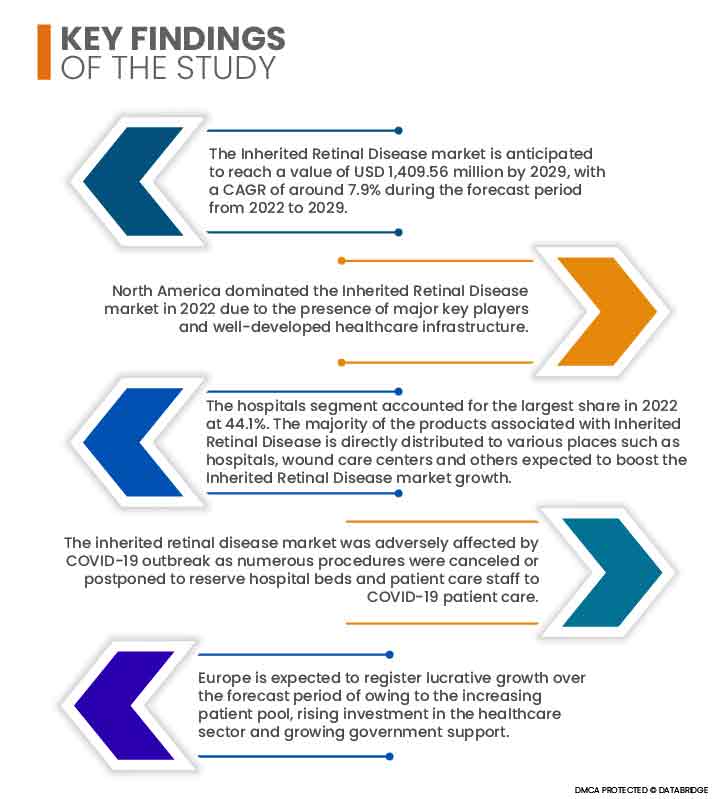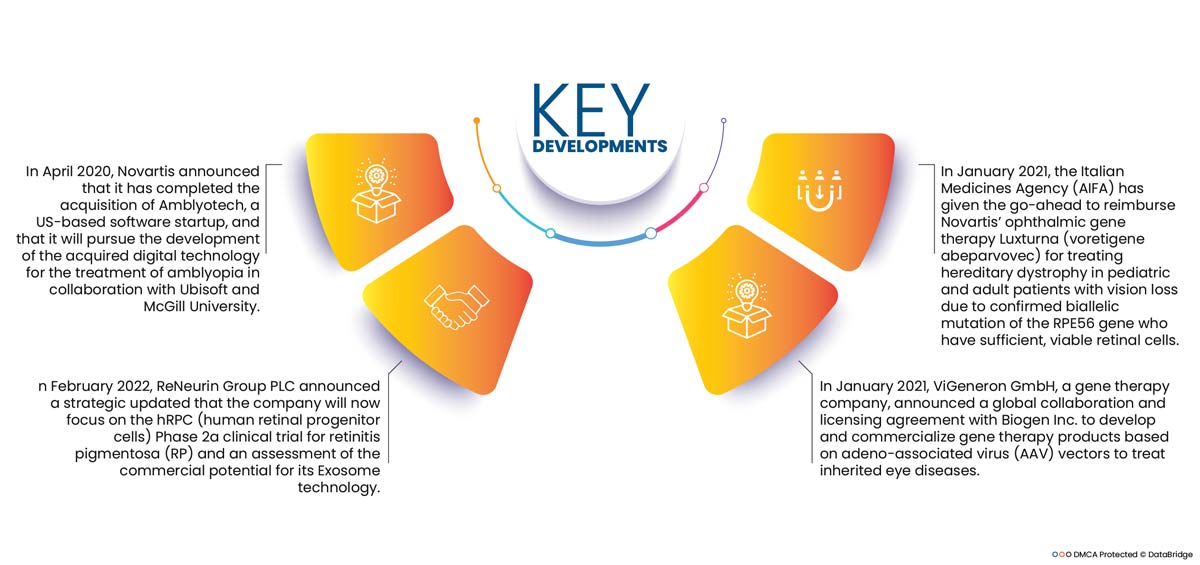Согласно статье, опубликованной в Nature 2021, распространенность моногенных IRD составляет приблизительно 1 на 2000 человек, затрагивая более двух миллионов человек во всем мире. Таким образом, ожидается, что растущая распространенность и постоянное обнаружение новых мутагенных участков, которые передаются генетически, будут выступать в качестве драйвера роста рынка. Таким образом, ожидается, что глобальный рынок наследственных заболеваний сетчатки будет быстро расти в течение прогнозируемого периода.
Доступ к полному отчету по адресу https://www.databridgemarketresearch.com/reports/global-inherited-retinal-diseases-market
Data Bridge Market Research анализирует, что рынок наследственных заболеваний сетчатки, как ожидается, будет расти в среднем на 7,9% в прогнозируемый период с 2022 по 2029 год и, как ожидается, достигнет 1 409,56 млн долларов США к 2029 году. Запуск продуктов компаниями на этом рынке по-прежнему обширен, учитывая все продукты в клинических испытаниях, и из-за чего выручка компаний непрерывно росла с последнего года выручки. Ожидается, что это увеличит размер рынка и станет драйвером для мирового рынка наследственных заболеваний сетчатки.

Ожидается, что увеличение объемов продукции на конвейере ускорит темпы роста рынка
Продукт на рынке наследственных заболеваний сетчатки может повлиять на рынок, поскольку размер рынка положительно увеличится, когда эти продукты будут одобрены на мировом рынке. Существуют различные продукты, и некоторые из них упомянуты ниже, которые находятся на стадии разработки. Например, Национальный институт глаз (NEI) Национального института здравоохранения, клинический центр (CC), проводит исследование по изучению переноса глазного гена RS1 при Х-сцепленном ретиношизисе на фазе 1/2 по состоянию на 3 мая 2021 года. Целью исследования является оценка безопасности и переносимости переноса гена вектора глазного AAV-RS1 (AAV8-scRS/IRBPhRS) в сетчатку участников, страдающих Х-сцепленным ювенильным ретиношизисом (XLRS). Поскольку активность клинических испытаний выходит на новый уровень, эта область, по-видимому, готова к быстрым и важным достижениям в исследованиях IRD и уходе за пациентами. Это всего лишь несколько общих испытаний, поэтому компании, работающие на этом рынке, постоянно проводят клинические испытания и подвергают своих кандидатов клиническим испытаниям. Ожидается, что это создаст новые возможности и будет способствовать развитию мирового рынка наследственных заболеваний сетчатки.
Область отчета и сегментация рынка
Отчет Метрика
|
Подробности
|
Прогнозируемый период
|
2021-2028
|
Базовый год
|
2020
|
Исторические годы
|
2019 (Можно настроить на 2014 - 2019)
|
Количественные единицы
|
Доход в млн. долл. США, объемы в единицах, цены в долл. США
|
Охваченные сегменты
|
По типу заболевания (пигментный ретинит, болезнь Штаргардта, ахроматопсия, дистрофия колбочек и палочек, хориоидеремия, врожденный амавроз Лебера, отек желтого пятна и другие), типу (диагностика и терапия), конечному пользователю (больницы, специализированные клиники, амбулаторные хирургические центры, домашняя медицинская помощь и другие), каналу сбыта (розничные продажи и прямые торги)
|
Страны, охваченные
|
США, Канада и Мексика в Северной Америке, Германия, Франция, Великобритания, Нидерланды, Швейцария, Бельгия, Россия, Италия, Испания, Турция, Остальная Европа в Европе, Китай, Япония, Индия, Южная Корея, Сингапур, Малайзия, Австралия, Таиланд, Индонезия, Филиппины, Остальная часть Азиатско-Тихоокеанского региона (APAC) в Азиатско-Тихоокеанском регионе (APAC), Саудовская Аравия, ОАЭ, Южная Африка, Египет, Израиль, Остальной Ближний Восток и Африка (MEA) как часть Ближнего Востока и Африки (MEA), Бразилия, Аргентина и Остальная часть Южной Америки как часть Южной Америки.
|
Охваченные участники рынка
|
Spark Therapeutics (США), Novartis AG (Швейцария), Okuvision (Германия), Nidek Co. Ltd. (Япония), Invitae Corporation (США), Zeiss AG (Германия), Optos (Австралия), Neurosoft (Греция), PIXIUM VISION (Франция), LKC TECHNOLOGIES, INC. (США), Renurone Group plc, Astellas Pharma (Япония), REGENXBIO Inc. (США), Ionis Pharmaceutics (США), Sparing Vision (Франция), Ocugen Inc (США), Johnson & Johnson (США), IVERIC bio (США), Second Sight (США), Coave Therapeutics (Франция), MeiraGTx Limited (Великобритания), Gensight Biologics (Франция), ProQR Therapeutics (Нидерланды), Bionic Vision Technologies (Австралия)
|
Точки данных, охваченные отчетом
|
Помимо таких рыночных данных, как рыночная стоимость, темпы роста, сегменты рынка, географический охват, участники рынка и рыночный сценарий, рыночный отчет, подготовленный командой Data Bridge Market Research, также включает в себя углубленный экспертный анализ, эпидемиологию пациентов, анализ воронки продаж, анализ цен и нормативную базу.
|
Анализ сегмента:
Глобальный рынок наследственных заболеваний сетчатки подразделяется на четыре основных сегмента, которые различаются по типу заболевания, типу, конечному пользователю и каналу сбыта.
- На основе типа заболевания рынок наследственных заболеваний сетчатки сегментируется на пигментный ретинит, болезнь Штаргардта, ахроматопсию, дистрофию колбочек и палочек, хоридеремию, врожденный амавроз Лебера (LCA), макулярный отек и другие. Ожидается, что в 2022 году сегмент пигментного ретинита будет доминировать на рынке с самым высоким среднегодовым темпом роста 9,6%.
Ожидается, что сегмент пигментного ретинита будет доминировать на рынке с самым высоким среднегодовым темпом роста в 9,6%.
Ожидается, что в 2022 году сегмент пигментного ретинита будет доминировать на рынке с самым высоким среднегодовым темпом роста 9,6% в период с 2022 по 2029 год. Сегмент пигментного ретинита доминирует на рынке наследственных заболеваний сетчатки из-за высокой заболеваемости этим заболеванием по сравнению с другими заболеваниями, что делает его более распространенным и имеет высокий уровень распространенности.
- На основе типа рынок наследственных заболеваний сетчатки сегментируется на диагностику и терапию. Ожидается, что в 2022 году сегмент терапии будет доминировать на рынке с самым высоким среднегодовым темпом роста 8,4% в прогнозируемый период с 2022 по 2029 год. Ожидается, что в 2022 году сегмент терапии будет доминировать на рынке с долей рынка 68,70% и, как ожидается, достигнет 998,08 млн долларов США к 2029 году с 523,52 млн долларов США в 2021 году, увеличившись с самым высоким среднегодовым темпом роста 8,4% в прогнозируемый период с 2022 по 2029 год.
- На основе конечного пользователя рынок наследственных заболеваний сетчатки сегментируется на больницы, специализированные клиники, амбулаторные хирургические центры, домашнюю медицинскую помощь и т. д. Ожидается, что в 2022 году сегмент больниц будет доминировать на рынке с самым высоким среднегодовым темпом роста в 9,1%.
Ожидается, что сегмент больниц будет доминировать на рынке с самым высоким среднегодовым темпом роста в 9,1%.
Ожидается, что в 2022 году сегмент больниц будет доминировать на рынке с самым высоким среднегодовым темпом роста в 9,1% в период с 2022 по 2029 год. Ожидается, что сегмент больниц будет доминировать на рынке наследственных заболеваний сетчатки, поскольку больницы специализируются на проведении различных хирургических вмешательств и имеют большой профессиональный портфель, доступный для надлежащего лечения. Более того, экономически эффективная и высококачественная диагностическая помощь и услуги в безопасной медицинской среде и удобны для консультирующего врача/медицинского учреждения для аутсорсинга массовых диагностических тестов в независимые диагностические лаборатории для лучшего обслуживания клиентов.
- На основе типа дистрибуции рынок наследственных заболеваний сетчатки сегментируется на прямой тендер, розничные продажи и другие. Ожидается, что в 2022 году сегмент розничных продаж будет доминировать на рынке с самым высоким среднегодовым темпом роста 8,5% в прогнозируемый период с 2022 по 2029 год. Ожидается, что сегмент розничных продаж будет доминировать на рынке наследственных заболеваний сетчатки. Они являются основным источником закупок диагностических и хирургических устройств и методов лечения организациями здравоохранения и специализированными клиниками. Закупка продукции через розничные продажи является высокорентабельной и удобной для поставщиков медицинских услуг.
Основные игроки
Data Bridge Market Research признает следующие компании основными игроками на рынке наследственных заболеваний сетчатки: Spark Therapeutics (США), Novartis AG (Швейцария), Okuvision (Германия), Nidek Co. Ltd. (Япония), Invitae Corporation (США), Zeiss AG (Германия), Optos (Австралия), Neurosoft (Греция), PIXIUM VISION (Франция), LKC TECHNOLOGIES, INC. (США), Renurone Group plc, Astellas Pharma (Япония), REGENXBIO Inc. (США), Ionis Pharmaceutics (США), Sparing Vision (Франция), Ocugen Inc (США), Johnson & Johnson (США), IVERIC bio (США), Second Sight (США), Coave Therapeutics (Франция), MeiraGTx Limited (Великобритания), Gensight Biologics (Франция), ProQR Therapeutics (Нидерланды), Bionic Vision Technologies (Австралия)

Развитие рынка
- В апреле 2020 года компания Novartis объявила о завершении приобретения Amblyotech, стартапа по разработке программного обеспечения из США, и о том, что она продолжит разработку приобретенной цифровой технологии для лечения амблиопии в сотрудничестве с Ubisoft и Университетом Макгилла. Amblyotech использует активную игровую и пассивную видеотехнологию с 3D-очками для тренировки глаз для совместной работы и просмотра изображения в целом. Ее программное обеспечение использует новое визуальное представление, известное как дихоптический дисплей, в котором каждому глазу показывается разное изображение с помощью запатентованного алгоритма. Программное обеспечение Amblyotech улучшило зрение как у детей, так и у взрослых в ранних клинических исследованиях с более быстрым началом, чем стандартные методы лечения4.
- В феврале 2022 года ReNeurin Group PLC объявила о стратегическом обновлении, в котором говорится, что теперь компания сосредоточится на клиническом исследовании hRPC (человеческие клетки-предшественники сетчатки) фазы 2a для пигментного ретинита (RP) и оценке коммерческого потенциала своей технологии Exosome. Это поможет компании коммерциализировать продукт на рынке в прогнозируемый период.
- В январе 2021 года компания ViGeneron GmbH, занимающаяся генной терапией, объявила о глобальном сотрудничестве и лицензионном соглашении с Biogen Inc. для разработки и коммерциализации продуктов генной терапии на основе векторов аденоассоциированного вируса (AAV) для лечения наследственных заболеваний глаз. Компании будут использовать запатентованные ViGeneron vgAAV, новые сконструированные капсиды AAV, для эффективной трансдукции ретинальных клеток посредством интравитреальных инъекций.
- В январе 2021 года Итальянское агентство по лекарственным средствам (AIFA) дало добро на возмещение расходов на офтальмологическую генную терапию Luxturna (voretigene abeparvovec) компании Novartis для лечения наследственной дистрофии у детей и взрослых с потерей зрения из-за подтвержденной биаллельной мутации гена RPE56, имеющих достаточное количество жизнеспособных клеток сетчатки.
Региональный анализ
Географически в отчете о рынке наследственных заболеваний сетчатки представлены следующие страны: США, Канада и Мексика в Северной Америке, Германия, Франция, Великобритания, Нидерланды, Швейцария, Бельгия, Россия, Италия, Испания, Турция, остальные страны Европы в Европе, Китай, Япония, Индия, Южная Корея, Сингапур, Малайзия, Австралия, Таиланд, Индонезия, Филиппины, остальные страны Азиатско-Тихоокеанского региона (APAC) в Азиатско-Тихоокеанском регионе (APAC), Саудовская Аравия, ОАЭ, Южная Африка, Египет, Израиль, остальные страны Ближнего Востока и Африки (MEA) как часть Ближнего Востока и Африки (MEA), Бразилия, Аргентина и остальные страны Южной Америки как часть Южной Америки.
Согласно анализу Data Bridge Market Research:
Северная Америка будет доминирующим регионом на рынке наследственных заболеваний сетчатки в течение прогнозируемого периода.
Северная Америка доминировала на рынке наследственных заболеваний сетчатки благодаря основным ключевым игрокам. Северная Америка продолжит доминировать на рынке наследственных заболеваний сетчатки с точки зрения доли рынка и доходов рынка и продолжит процветать в течение прогнозируемого периода. Это связано с растущим внедрением передовых технологий и хорошо развитой инфраструктурой здравоохранения в этом регионе.
По оценкам, Европа является самым быстрорастущим регионом на рынке наследственных заболеваний сетчатки.
Ожидается, что Европа будет расти в течение прогнозируемого периода из-за растущих инвестиций в сектор здравоохранения в этом регионе. В дополнение к этому, ожидается, что увеличение пула пациентов и растущая государственная поддержка будут способствовать темпам роста рынка в этом регионе.
Анализ воздействия COVID-19
Вспышка COVID-19 в значительной степени повлияла на отрасль наследственных заболеваний сетчатки. Блокировки и изоляция во время пандемий усложняют управление заболеваниями и соблюдение режима приема лекарств. Социальная изоляция усиливает стресс, отчаяние и социальную поддержку, что может привести к снижению соблюдения режима приема противосудорожных препаратов во время пандемии. Поскольку число пациентов с COVID-19 в больницах увеличилось, многочисленные процедуры были отменены или отложены, чтобы зарезервировать больничные койки и персонал по уходу за пациентами для ухода за пациентами с COVID-19. Отсутствие доступа к медицинским учреждениям для планового лечения и приема лекарств еще больше повлияет на рынок.
С другой стороны, во всем мире наблюдается снижение числа пациентов с COVID-19, что приведет к повышению внимания к заболеваниям глаз. Более того, ограничения и меры, вероятно, будут смягчены, что поможет рынку увидеть небольшой прирост, поскольку производители сосредоточены на различных разработках и инновациях, рыночных тенденциях и других стратегиях расширения. Таким образом, рынок наследственных заболеваний сетчатки будет расти ускоренными темпами после COVID-19.
Часто задаваемые вопросы (FAQ)
Для получения более подробной информации об отчете о рынке наследственных заболеваний сетчатки нажмите здесь – https://www.databridgemarketresearch.com/reports/global-inherited-retinal-diseases-market










